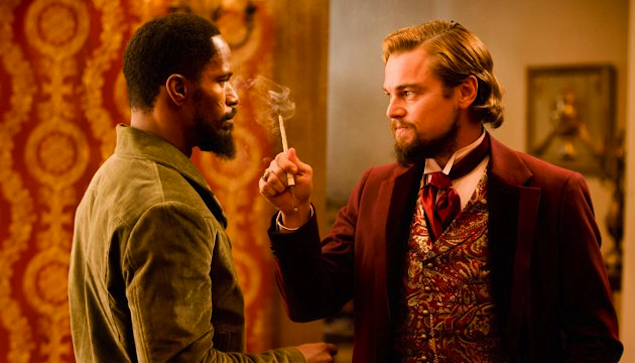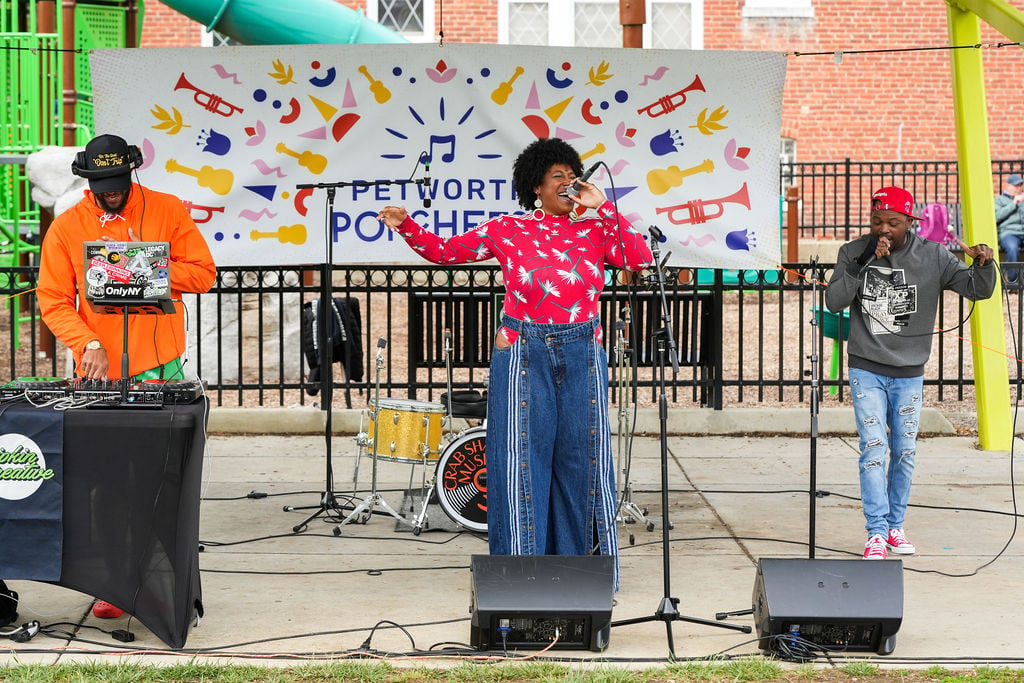Quentin Tarantino knows that vengeance makes a great engine to drive a narrative.
Ever since
Kill Bill, he’s worked exclusively with revenge stories, overlaying his violent tales with
a bloodstained but appealing sheen of wish-fulfillment payback. In his half of 2007’s
grindhouse double feature,
Death Proof, it was a group of women turning the tables on a predatory, murderous misogynist.
Inglorious Basterds rewrote the narrative of World War II so that a squad of elite Jewish soldiers could
be seen hunting and killing Nazis, and eventually taking down the Führer himself.
Now, with
Django Unchained, Tarantino turns in a story of one slave exacting revenge on those who captured and
abused him, his wife, and essentially all slaves everywhere.
Jamie Foxx plays the titular character, who is freed at the start of the story by
a German bounty hunter, King Schultz (Christoph Waltz) in exchange for helping him
to identify three men that Schultz is trying to track down for a bounty. Discovering
that Django is a natural at the bounty-hunting game, he offers to partner up with
him and eventually assist Django in going back to rescue his wife, Broomhilda (Kerry
Washington), who is still enslaved by ruthless and cruel plantation owner Calvin Candie
(Leonardo DiCaprio). Django bears some similarities to
Basterds, but the storyline is more linear, and Tarantino also indulges in more over-the-top
exploitation-cinema touches; much of the violence is more cartoonish, with exaggerated
spatters of blood and epic gun battles.
But this sometimes silly violence serves a purpose: It contrasts the moments of truly
disturbing violence that Tarantino puts on display, always within the context of the
brutality doled out to slaves at the hands of white masters. That touch grounds
Django firmly in the grim realities of slavery, and allows the director to address serious
issues of the legacy and moral stain of slavery on this country, even as these moments
are woven within a film that is perhaps one of Tarantino’s funniest and most wildly
entertaining.
View the
trailer. Opens Christmas Day
at theaters across the
area.
French director Jacques Audiard’s 2009 gangster fable,
A Prophet, was one of the most celebrated films of that year, and this year he follows up with
a work that doesn’t disappoint, even with the bar raised by that earlier work. Marion
Cotillard stars as Stéphanie, a killer whale trainer who loses both of her legs above
the knees in a freak accident at the water park where she works. Belgian actor Matthias
Schoenaerts, who wowed audiences last year in the Oscar-nominated
Bullhead, is Ali, a former mixed martial arts streetfighter trying to move his livelihood
to less shady, less punishing areas for the sake of his young son. He meets Stéphanie
before her accident at a club where he’s working security, and after she loses her
legs, deep in a depression over the loss of her limbs, she calls him up, and they
start an odd frienship/affair.
Audiard beautifully draws parallels between Stéphanie’s new physical disability and
the emotional deficiencies that cause Ali to keep the world at arm’s length. Both
of these individuals are damaged, both proud, both reluctant to ask for help. They
find that help in each other, and while that may sound like treacly pseudo-inspirational
material, Audiard’s script doesn’t treat these two as vessels to try to teach a lesson,
but rather as real and rough-edged characters struggling mightily. Cotillard and Schoenaerts
both deliver unforgettable performances: She is wounded, unsure, yet still often headstrong,
while he uses his imposing physical presence as a muscular wall that partially obscures
his own wounds.
View the
trailer. Opens Friday at E
Street,
Bethesda
Row,
and the Angelika
Mosaic.
Fans of the wildly popular musical adaptation of Victor Hugo’s 1862 novel—about one
man’s search for redemption in pre-revolutionary France, and the group of cops, prostitutes,
and revolutionaries that come into his orbit during the years covered in the story—will
find plenty to love about Tom Hooper’s cinematic adaptation. Abandoning the way movie
musicals are normally made, with actors lip-syncing to their prerecording singing,
Hooper has all the actors singing on set, allowing the performers more freedom to
act in the moment rather than trying to match up to a sound booth performance they
may have delivered weeks or months previously. If Anne Hathaway wins an Oscar for
Best Supporting Actress for her portrayal of Fantine, the success of her performance
can be traced directly to that technique; her delivery of the showstopping early number
“I Dreamed a Dream” is a knockout, and nearly unimaginable using the usual methods
of shooting a musical. The other performances in the film benefit equally.
The problem lies in the fact that with the audio recorded on set, using cutaways,
multiple angles, and multiple takes in the same sequence becomes a far more difficult
task. Hooper’s decision to deal with this problem is to shoot the vast majority of
the songs in hovering close-ups and long takes, with the effect being an oddly claustrophobic
feeling for such an expansive story. That closed-in feeling isn’t aided by the fact
that many backgrounds and establishing shots of Paris are digitally rendered with
terrible-looking CGI, making what ought to be a lustrous and rich musical into something
that often feels cheap. The overall impression is one of a great idea poorly executed,
but the quality of the performances go a long way to save Hooper’s directorial missteps
from being disastrous to the film.
View the
trailer. Opens Christmas Day
at theaters across the
area.
Welcome to the future. Not too long ago, repertory
theaters would promote new restorations
of classic films that were being shown on pristine new
35-millimeter prints. But time
are changing, as are DC’s screening
rooms,
and the brief retrospective opening this weekend at the
National Gallery is a sign
of the new digital times: a pair of classics from French master
Marcel Carné, restored
specifically for the new theater projection standard, DCP. The
regretful abandonment
of film aside, this is actually good news; the transition to
digital has been outpacing
the transfer of many old films to the DCP format, meaning that
many repertory theaters
wanting to show old titles for which there are no prints
available to rent are reduced
to showing a Blu-ray copy, which is hardly ideal. So the more
old films that get this
kind of treatment, the better for venues like the National
Gallery to show the best
possible digital version of these movies. The two films in this
weekend’s series are
Carné’s epic masterpiece
Children of Paradise, about the artists’ culture of one street in Paris, and his early film,
Port of Shadows, looks at the seedy underworld of the port town of Le Havre.
View the trailer for Port of Shadows, which screens Saturday at 4. Children of Paradise
screens Sunday at 2 (with an encore presentation December 30 at the same time) at
the National Gallery of Art. Free.
Fans of spaghetti Westerns will be immediately familiar with the name of the hero
of Tarantino’s latest, as it’s taken from Sergio Corbucci’s legendarily dark and violent
1966 film. Corbucci’s
Django, with Franco Nero in the title role, gave rise to not just an unofficial series,
but practically a complete cinematic subculture of dozens of “sequels,” which were
almost entirely cheap knockoffs designed to capitalize on the popularity of the original;
the only official sequel, with Nero returning, came some 21 year later. Tarantino’s
film continues the long tradition of Django as an instrument of bloody vengeance,
and in the original incarnation, Nero’s Django is a chilling presence, a man who wanders
the west dragging a coffin behind him, seeking out the man who killed his wife. It’s
a relentlessly grim film, a vision of the Old West unadorned with the optimism of
many American Westerns, which often used the roughness of life in the West to promote
an American exceptionalism, as frontiersmen (almost always men) rose up to these challenges
and prevailed, the cinematic embodiment of manifest destiny. Corbucci’s counterprogramming
showed the West as a chaotic and corrupting wasteland, and the gold that drove much
of that migration West is a symbol of greed that leads even heroes into ruin.
View the trailer. Friday and Saturday
nights and midnight at E Street.
Blu-ray/DVD Pick of the Week:
Killer Joe
One of the most fascinating developments in movies in 2012 has been the reinvention
of Matthew McConaughey, or at least his decision to return to the sorts of roles that
made him so promising to begin with. Before he began popping up as a leading man in
tepid romantic comedies, he was showing great promise in intense character roles as
deranged psychos and sleazy rednecks. This year, McConaughey combined his talent for
Southern-fried sleaze with his leading-man charisma for a number of performances that
are among the best in his career, from
Magic Mike to
The Paperboy to
Bernie. But no performance reached the heights of either sleaze or magnetism as the one
he delivered in William Friedkin’s adaptation of the Tracy Letts play
Killer Joe, in which he portrays a cop who moonlights as hitman. He’s drawn into the drama of
a darkly comical and profoundly dysfunctional trailer trash clan, the father and son
of which hire him to kill the mother, putting up the younger sister as human collateral
should they fail to come up with the cash for the job. Not surprisingly, the scheme
to come up with the money backfires, and when Joe comes to collect, the film hits
disturbing, violent, and wildly entertaining heights—or depths, depending on how you
want to look at it. You can read more of my thoughts on the film in my
Washingtonian review
from this summer.
Special Features: Interviews with cast members and a brief behind-the-scenes featurette.


















